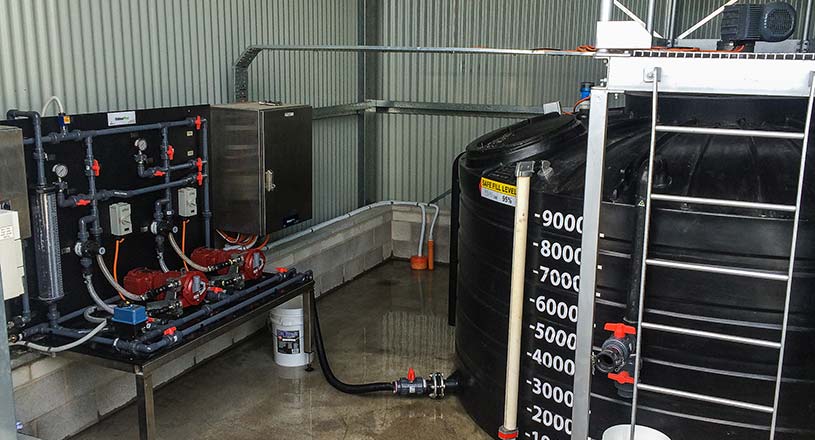Your guide to chemical dosing pump calibration and maintenance
The most effective form of odour control for wastewater systems is chemical dosing. But in order for these systems to be effective, the right amount of dosing chemical must be constantly injected into the wastewater stream. Setting up and calibrating chemical dosing systems is critical to ensure that the desired odour reduction is achieved, without wasting chemicals through overuse.
Cleanawater has the technical expertise to design the right chemical dosing system for your application as well as troubleshoot it and maintain it so that it keeps performing at optimum levels. We supply ferrous dosing, magnesium hydroxide, or calcium nitrate systems.
Cleanawater can advise you on the correct calibration and dosing pump flow rate for your system. Get in touch for expert advice.
Initial dosing pump calibration

There are two main types of pumps used for chemical dosing. Peristaltic pumps work on the principle of chemicals being squeezed out of a flexible tubing by a rotating roller. The dosing pump flow rate is controlled by the speed of pump rotation. Diaphragm pumps are controlled by electrical pulses. The higher frequency the pulses, the more chemical injection occurs.
Engineers must study the wastewater conditions in order to design a sufficient chemical dosing system. The results of this investigation will lead to a pump size specification and tank size for the dosing chemical. Typical steps for developing an engineering design for a chemical dosing system are as follows:
-
Obtain the normal wastewater flow range as well as expected minimum and maximum.
-
Check the pH range of the wastewater (for magnesium hydroxide dosing).
-
Check the normal sulphide content of the wastewater as well as expected minimum and maximum levels (for ferrous or calcium nitrate dosing).
-
Determine the pressure in the wastewater system at the point of injection.
Once the wastewater quality is known, this information can be used to determine how much dosing chemical is needed per litre of wastewater. Multiply this figure by the flow rate of the wastewater to get the dosing pump capacity. Engineers typically specify a minimum and maximum operating range based on the range of wastewater conditions and flow.
The dosing pump flow rate is not the only specification for pump sizing; a required discharge pressure must also be calculated. The dosing pump discharge must always be higher than the wastewater pressure to ensure that the chemical always has sufficient force to enter the wastewater stream.
Automatic flow adjustment
Cleanawater chemical dosing systems come with Programmable Logic Controllers (PLCs). These computer systems monitor the wastewater dosing pump flow rate and adjust the chemical dosing rate automatically.
Automatic flow adjustment is vital to ensure that enough dosing chemical is injected during peak flow conditions to keep odours under control. It also prevents overdosing and the high cost of wasted chemicals.
While automatic flow adjustment takes care of changing wastewater flow, it does not account for changes in wastewater quality. If for some reason there is a significant change in wastewater quality, the chemical dosing system will have to be recalibrated for the new conditions.
Troubleshooting a chemical dosing system

Cleanawater offers maintenance and service contracts in order to keep your chemical dosing system working as designed. However, there are some basic checks you can do to help determine if there is something wrong:
-
Keep a record of daily inspections of the dosing chemical tank level. Any change in chemical use will show up in the trend of level changes.
-
Monitor dosing pump alarm conditions such as discharge pressure and pump not running. These alarms can also be connected to telemetry for remote monitoring so that faults can be instantly picked up.
-
Make immediate investigations into odour complaints. A rise in complaints normally indicates a problem with chemical dosing effectiveness.
Maintaining chemical dosing pumps
Routine maintenance activities for chemical dosing pumps are designed to keep the system functioning. These tasks include inspection and cleaning of inline filters and checking component parts of the chemical dosing system for leaks. Remove, inspect, and clean the injection quill to prevent blockages. Pump performance is measured through checking pressure gauge readings.
Major maintenance tasks are also required at less frequent intervals but are just as important for long-term dosing performance. These tasks include flushing and cleaning of the chemical storage tank to eliminate any sludge build-up or solids that could block the system. Due to the harsh wastewater environment, it may also be necessary to reseal the bunded area from time to time. Pump components are prone to wear over time and should be replaced when their performance is compromised.
Contact Cleanawater for expert advice
Cleanawater specialises in wastewater odour control and chemical dosing systems. We design and size our systems according to each client's specific wastewater quality and dosing pump flow rate, with systems calibrated for optimum chemical usage.
Our service and maintenance contracts give you peace of mind that your odour control system is performing as per your requirements.
Find out more about our chemical dosing systems, or call our expert team on 1800 353 788 to arrange a consultation.
Must Read
What to Expect During a Modular Wash Bay Installation
CleanaWater, we make the process of installing a modular wash bay on your site as smooth and straightforward as possible. ...
Read moreThe CleanaWater Team Driving Water Treatment and Sustainability
CleanaWater is powered by a dedicated team of professionals who bring expertise and passion to every project. ...
Read more